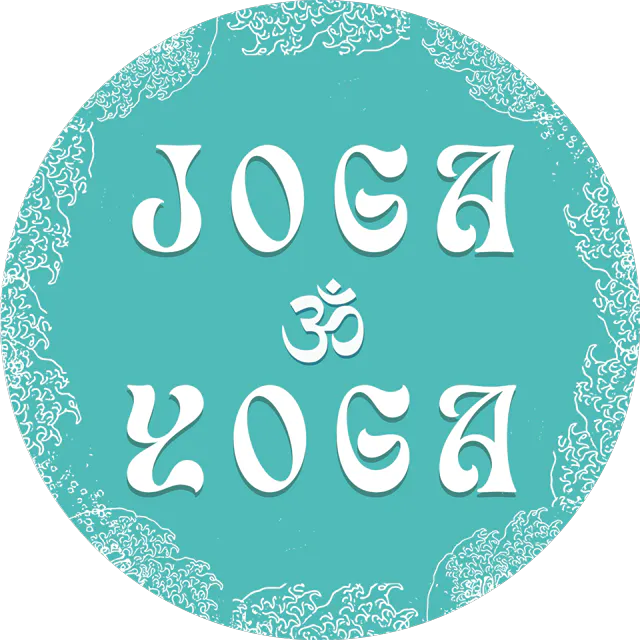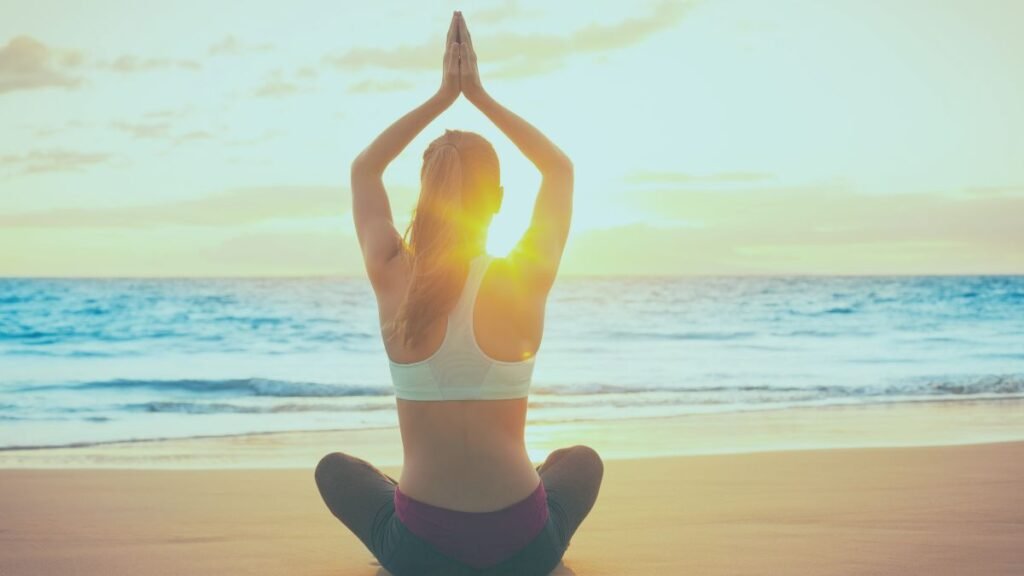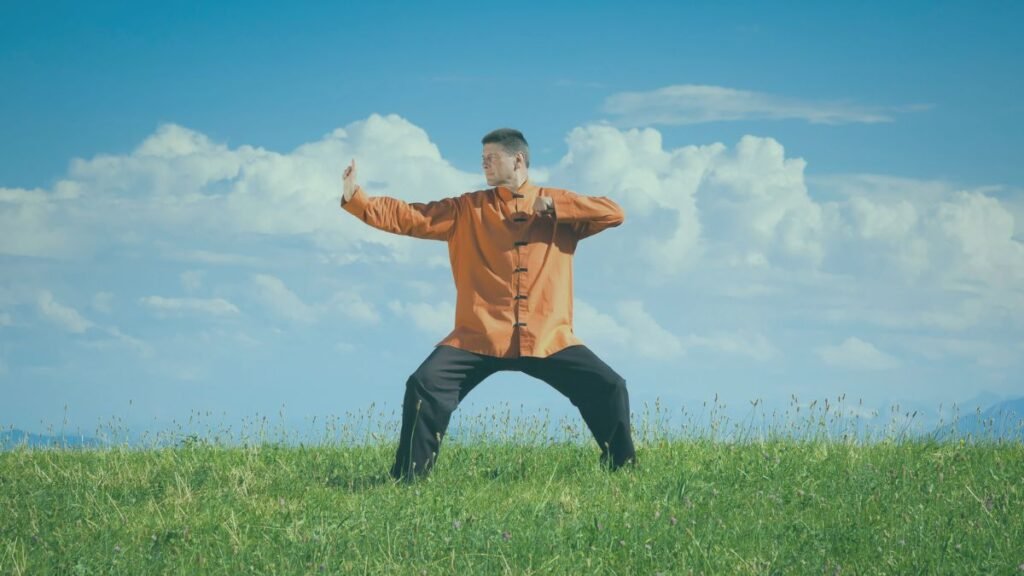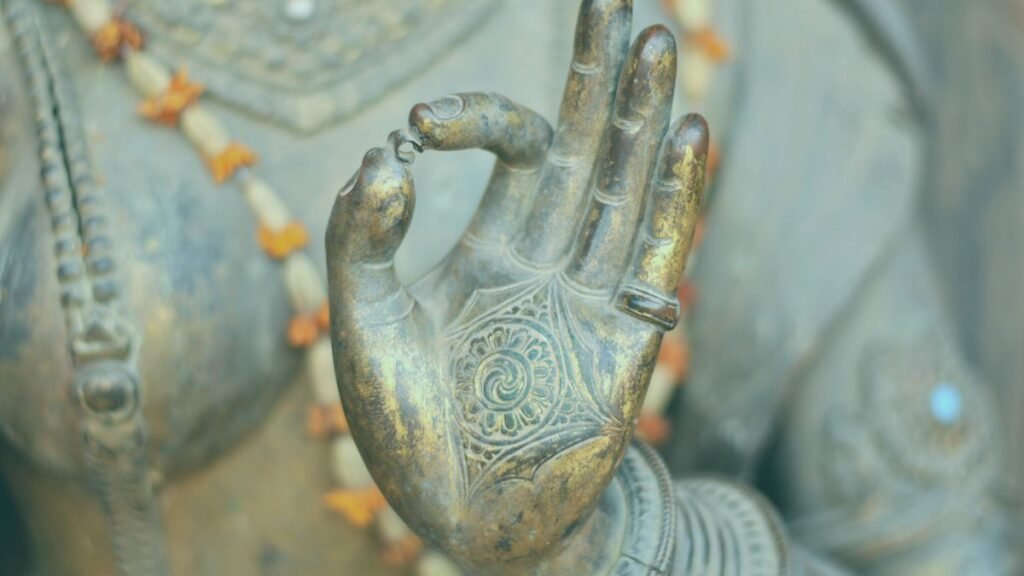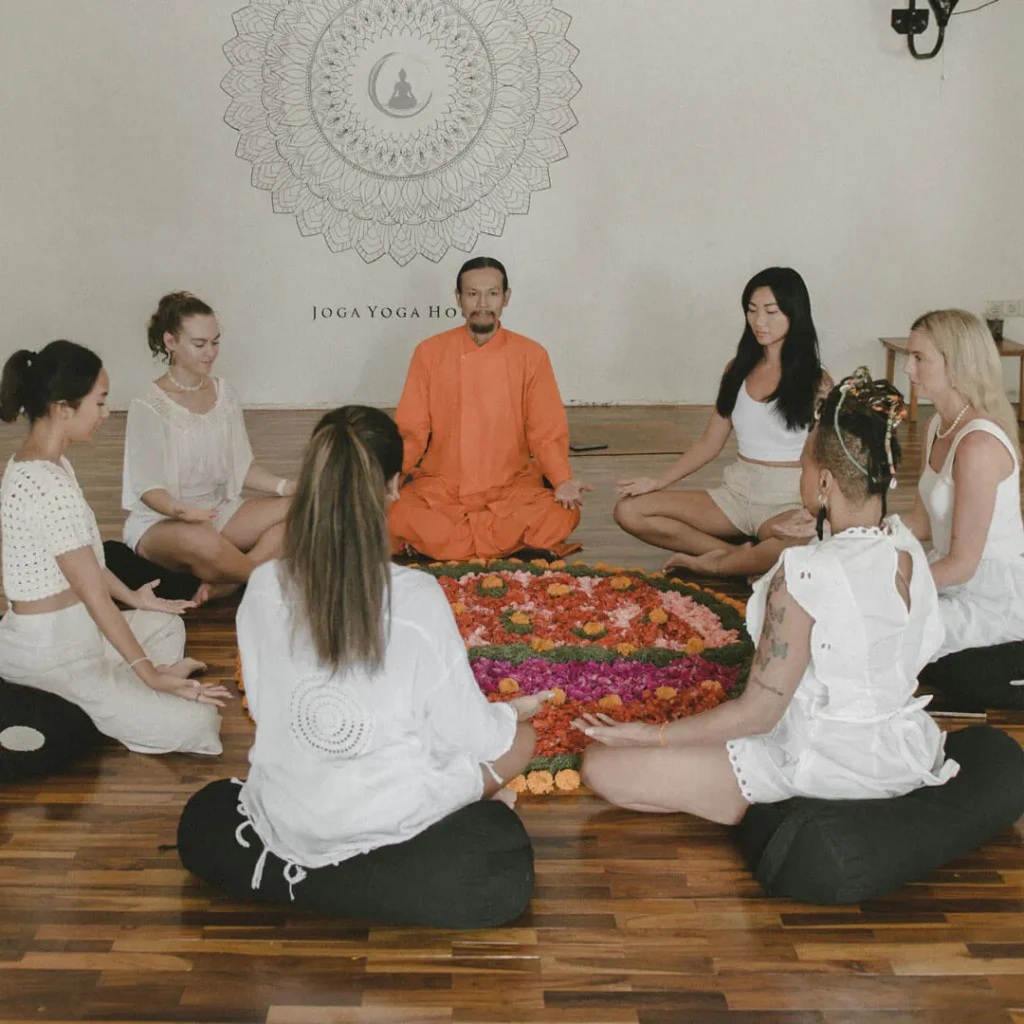A yoga mudra is a symbolic hand gesture that directs energy flow and balances the body’s five elements. Learn the meaning, benefits, and eight essential mudras.
What Is a Mudra in Yoga?
A mudra is a hand gesture that channels energy, balances the body’s five elements, and deepens meditation.
The word comes from Sanskrit: mud = joy, dra = gesture/seal. By creating a “seal” with the hands, energy is redirected within the body, supporting both physical and mental balance.
Types of mudras include:
- Hasta (hand mudras): the most common, using fingers to redirect energy.
- Kaya (postural mudras): combining body positions with energy flow.
- Mana (mental mudras): focused on gaze, visualization, or subtle awareness.
One example is the Yoni Mudra, which cultivates stillness, inner awareness, and balance. It’s often taught alongside Pranayama Yoga to deepen focus during meditation.

What Are the Benefits of Practicing Mudras?
Yoga mudras improve concentration, reduce stress, balance energy, and support healing by influencing prana (life force) flow in the body.
- Physical Benefits: Better sleep, improved digestion, joint mobility, and reduced fatigue.
- Mental Benefits: Greater clarity, reduced anxiety, and sharper focus for study or work.
- Spiritual Benefits: Chakra activation, deeper meditation, and enhanced energy balance.
Many teacher training students at Joga Yoga Bali explore mudras alongside asanas, pranayama, and meditation. Practicing them daily supports both personal growth and professional teaching skills.
How Do Mudras Work With the Five Elements?
Mudras balance Agni (fire), Vayu (air), Akasha (space), Bhumi (earth), and Jala (water), restoring harmony when these elements are imbalanced. Each finger corresponds to an element, and mudras use this link to guide energy.
Elements, Fingers, and Related Mudras
| Element | Finger | Related Mudra |
| Agni (Fire) | Thumb | Surya Mudra |
| Vayu (Air) | Index Finger | Gyan Mudra / Vayu Mudra |
| Akasha (Space) | Middle Finger | Shunya Mudra |
| Bhumi (Earth) | Ring Finger | Prithvi Mudra / Apan Mudra |
| Jala (Water) | Little Finger | Varun Mudra |
Which Are the Most Powerful Mudras in Yoga?
Eight foundational mudras support balance, focus, and wellness in daily life. They can be practiced anywhere, usually for 15–45 minutes daily, or in shorter sessions repeated throughout the day.
Gyan Mudra (Knowledge)
Benefits: Improves memory, concentration, and reduces stress. Stimulates the nervous system and pituitary gland.
How to do: Touch the tip of the index finger to the thumb; keep other fingers extended. Practice during meditation or pranayama.
Vayu Mudra (Air)
Benefits: Calms restlessness, anxiety, and Vata imbalance. Supports relief from arthritis, sciatica, and joint stiffness.
How to do: Bend the index finger to the base of the thumb, pressing gently with the thumb. Keep other fingers straight.
Prana Mudra (Life)
Benefits: Boosts vitality, strengthens immunity, and improves eyesight. Reduces fatigue and restlessness.
How to do: Touch the tips of the ring finger and little finger to the thumb, keeping index and middle fingers extended.
Shunya Mudra (Emptiness)
Benefits: Eases ear pain, improves hearing, and supports throat health. Balances the space element.
How to do: Bend the middle finger to touch the base of the thumb, then press it gently with the thumb. Keep other fingers straight.
Apan Mudra (Digestion)
Benefits: Improves digestion, detoxifies the body, supports kidney and liver function.
How to do: Touch the tips of the middle and ring fingers to the thumb, while extending the index and little fingers.
Surya Mudra (Sun)
Benefits: Boosts metabolism, aids in weight management, and increases warmth in the body.
How to do: Bend the ring finger and press it with the thumb. Keep other fingers straight.
Varun Mudra (Water)
Benefits: Hydrates the body, improves skin health, and reduces dryness. Encourages clear communication.
How to do: Lightly touch the little finger to the thumb, keeping other fingers extended.
Ling Mudra (Heat)
Benefits: Generates body heat, strengthens the lungs, and helps relieve colds, asthma, and sinus issues.
How to do: Interlock the fingers of both hands, keeping the right thumb upright and encircled by the left hand.
8 Essential Yoga Mudras
| Mudra | Benefits | How to Do |
| Gyan (Knowledge) | Boosts memory, focus, reduces stress | Touch index finger to thumb, extend others |
| Vayu (Air) | Calms anxiety, relieves joint issues | Press index finger to thumb, keep others straight |
| Prana (Life) | Energizes body, strengthens immunity | Touch ring & little fingers to thumb, extend others |
| Shunya (Emptiness) | Eases ear pain, supports throat health | Press middle finger to base of thumb with thumb |
| Apan (Digestion) | Improves digestion, detoxifies organs | Touch middle & ring fingers to thumb, extend others |
| Surya (Sun) | Aids weight loss, increases body warmth | Press ring finger with thumb, extend others |
| Varun (Water) | Improves hydration, skin, communication | Touch little finger to thumb, extend others |
| Ling (Heat) | Generates heat, relieves colds/asthma | Interlock fingers, keep right thumb upright |
How Long Should You Practice a Yoga Mudra?
Most yoga mudras are practiced for 15–45 minutes daily, or in shorter 5–10 minute sessions repeated throughout the day. Consistency is more important than duration — even short, mindful practice can create benefits.
Practice Guidelines
- Beginners: Start with 5–10 minutes, then gradually extend. See our Beginner Yoga Guide for safe starting points.
- Intermediate/Advanced: Hold mudras for 20–30 minutes during meditation or pranayama. Pairing with Pranayama Yoga enhances results.
- Meditation Practice: Combine mudras with seated meditation for deeper focus. Our Meditation in Canggu Guide shares local spots to practice with calm surroundings.
Many students in Yoga Teacher Training Bali incorporate mudras into their daily routines, building both personal discipline and teaching skills.
Can Mudras Be Part of Yoga Teacher Training?
Yes. Mudras are often included in 200-hour yoga teacher training programs as foundational tools for meditation, energy balance, and teaching methodology.
At Joga Yoga Bali, students explore mudras alongside asanas, pranayama, and meditation practices. Learning how to integrate mudras into sequencing and breathwork prepares future teachers to share these techniques with confidence.
Why Mudras Belong in Teacher Training
- Energy Awareness: Understanding how hand gestures redirect prana.
- Meditation Tools: Deepening focus and concentration during practice.
- Teaching Skills: Guiding students through both physical and subtle practices.
If you are considering teacher training, explore the Yoga Teacher Training in Bali Guide to learn how mudras, pranayama, and meditation are woven into the curriculum.

Conclusion
Yoga mudras are more than symbolic gestures — they are powerful tools for balancing the body’s five elements, calming the mind, and deepening meditation. From Gyan Mudra for focus to Prana Mudra for vitality, these practices can be integrated into daily life in just minutes.
At Joga Yoga Bali, students explore mudras within a complete yoga journey that includes asana practice, pranayama, and meditation. Whether you are a beginner or preparing for yoga teacher training in Bali, mudras offer simple yet profound ways to enhance your practice.
👉 Ready to go deeper? Join a yoga class in Canggu and experience how mudras, breath, and movement work together.
FAQs About Yoga Mudras
What is the meaning of mudra in yoga?
A mudra is a hand gesture or position that directs prana (energy) and balances the body’s five elements. They are used in meditation, pranayama, and daily yoga practice.
Can beginners practice yoga mudras?
Yes. Mudras are safe for all levels and easy to learn. Start with 5–10 minutes daily. See our Beginner Yoga Guide for tips.
How long should you hold a mudra?
Most mudras are practiced for 15–45 minutes daily, or in shorter 5–10 minute sessions repeated through the day. Consistency matters more than duration.
Which mudra is best for stress relief?
Gyan Mudra and Prana Mudra are most commonly practiced for calming the mind and balancing energy. For a complete stress routine, see Yoga for Stress Relief.
Do mudras help in meditation?
Yes. Mudras like Yoni Mudra deepen inner stillness and concentration. Explore our Meditation in Canggu Guide for places to practice.
Are mudras part of yoga teacher training?
Yes, mudras are taught in many 200-hour teacher trainings. Learn more in our Yoga Teacher Training in Bali Guide.
